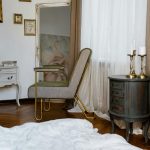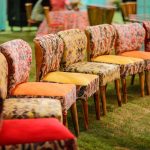To get mold out of your fabric lawn chairs, start by spotting those fuzzy or discolored patches and wearing gloves and a mask for safety. Spray white vinegar on the moldy areas and let it sit for an hour. Then sprinkle baking soda, scrub gently, rinse with warm water, and dry the chairs thoroughly in the sun to kill spores. Using these simple steps helps keep your chairs fresh—discover more ways to protect and maintain them for long-lasting outdoor enjoyment.
Table of Contents
Key Takeaways
- Identify mold by looking for fuzzy spots, musty smell, and discoloration on the fabric of lawn chairs.
- Spray white vinegar on moldy areas, let sit for an hour, then sprinkle baking soda and gently scrub.
- Rinse the fabric with warm water to remove cleaning residues after scrubbing with vinegar and baking soda.
- Air dry chairs thoroughly in direct sunlight and well-ventilated spaces to kill remaining mold spores.
- Wear protective gloves and mask during cleaning, and store chairs dry to prevent future mold growth.
Identifying Mold on Fabric Lawn Chairs
How can you tell if your fabric lawn chairs have mold? First, check for visible signs like black, green, or white fuzzy spots on the fabric surface.
Mold often appears in damp, shaded areas or where moisture tends to linger. You might also notice a musty, earthy smell—this odor is a clear indicator mold is present.
Pay attention to any discoloration or stains that don’t come off with regular cleaning. If the fabric feels damp or sticky, mold could be growing beneath the surface.
Watch for stubborn stains and dampness—signs mold may be lurking beneath the fabric’s surface.
Don’t ignore these warning signs, as mold can spread quickly and damage the fabric. Early identification helps you address the problem before it worsens, keeping your lawn chairs safe and looking fresh.
Preparing Your Cleaning Supplies
Gathering the right cleaning supplies is essential for effectively removing mold from your fabric lawn chairs.
You’ll want to have everything ready before you start to make the process smoother and more efficient. Here’s a quick checklist of what you’ll need:
- Soft brush or scrub brush to gently remove mold spores
- White vinegar for its natural mold-killing properties
- Baking soda to help deodorize and lift stains
- Spray bottle to apply cleaning solutions evenly
- Protective gloves and a mask to keep yourself safe from mold exposure
Having these items on hand will guarantee you’re well-prepared to tackle mold without damaging your fabric lawn chairs.
Once your supplies are ready, you’ll be set to move forward confidently with the cleaning process.
Steps to Remove Mold Using Vinegar and Baking Soda
With your cleaning supplies ready, you can start tackling the mold on your fabric lawn chairs using vinegar and baking soda.
First, spray white vinegar directly onto the moldy areas and let it sit for about an hour. Vinegar kills mold spores and loosens grime.
Spray white vinegar on moldy fabric and let it sit for an hour to kill mold spores and loosen grime.
Next, sprinkle baking soda over the same spots to deodorize and scrub gently with a soft brush or cloth.
After scrubbing, rinse the fabric with warm water to remove residue.
Finally, allow the chairs to air dry completely in a sunny, well-ventilated area to prevent mold from returning.
If any mold remains, repeat the process.
This natural method is effective, safe, and budget-friendly, giving your fabric lawn chairs a fresh, mold-free look without harsh chemicals.
Using Commercial Mold Cleaners Safely
Although natural remedies work well for mild mold, stubborn or extensive growth may require commercial mold cleaners. When using these products, you need to handle them carefully to protect yourself and your lawn chairs.
Keep these safety tips in mind:
- Wear gloves and a mask to avoid skin and respiratory irritation.
- Work in a well-ventilated area to reduce inhaling fumes.
- Follow the product instructions exactly—don’t mix cleaners.
- Test the cleaner on a small, hidden fabric area first to check for damage.
- Rinse thoroughly after cleaning to remove any chemical residue.
Drying and Preventing Future Mold Growth
After cleaning your fabric lawn chairs, make sure you dry them thoroughly to stop mold from coming back.
Letting them sit in direct sunlight can help kill leftover spores and speed up drying.
To keep mold away in the future, store your chairs in a dry spot and clean them regularly.
Thorough Drying Techniques
To effectively dry your fabric lawn chairs and prevent mold from returning, you’ll need to guarantee they’re completely moisture-free. Even slight dampness can encourage mold growth, so thorough drying is essential.
After cleaning, follow these steps:
- Wipe down fabric with a dry towel to remove excess water.
- Use a fan or portable blower to circulate air around the chair.
- Position chairs in a well-ventilated area to speed evaporation.
- If indoors, consider a dehumidifier to reduce ambient moisture.
- Allow chairs to dry for at least 24 hours, checking regularly for any damp spots.
Sunlight Exposure Benefits
When you expose your fabric lawn chairs to direct sunlight, you not only speed up drying but also harness the sun’s natural ability to kill mold spores. Ultraviolet (UV) rays break down the mold’s cell structure, effectively reducing its presence on your chairs.
Plus, the warmth from sunlight dries any remaining moisture, making the environment less hospitable for mold to return. Make sure to position your chairs so all fabric surfaces get ample sun exposure. Rotate them occasionally to cover every area evenly.
Keep in mind, though, prolonged exposure might fade colors, so balance sun time wisely. Overall, using sunlight is a simple, eco-friendly way to eliminate mold and help keep your fabric lawn chairs fresh and dry.
Mold Prevention Tips
Although removing mold is essential, preventing it from coming back is even more important to keep your fabric lawn chairs in good shape.
You’ll want to focus on drying and creating an environment that discourages mold growth. To do this, follow these simple tips:
- Always dry chairs completely after rain or cleaning.
- Store chairs in a well-ventilated, sunny spot.
- Use a moisture absorber or silica gel near storage areas.
- Avoid stacking damp chairs to allow airflow.
- Regularly clean fabric with mild detergent to remove dirt and spores.
Tips for Maintaining Mold-Free Outdoor Furniture
Since outdoor furniture faces constant exposure to moisture and changing weather, you’ll need to take proactive steps to keep mold at bay. Regular cleaning, proper storage, and using protective covers can make a big difference. Here are practical tips to maintain mold-free fabric lawn chairs:
| Tip | Action |
|---|---|
| Clean Weekly | Wipe down with mild detergent |
| Dry Thoroughly | Air dry completely after rain |
| Use Covers | Protect from rain and humidity |
| Store Indoors | Keep in a dry space when not in use |
| Inspect Regularly | Check for early mold signs and treat |
Frequently Asked Questions
Can Mold on Fabric Lawn Chairs Cause Health Issues?
Yes, mold on fabric lawn chairs can cause health issues, especially if you have allergies or asthma. You’ll want to clean it promptly to avoid respiratory problems, skin irritation, or worsening symptoms. Stay safe!
Is It Safe to Use Bleach on Fabric Lawn Chairs?
You can use bleach on fabric lawn chairs, but be cautious. It might discolor or weaken the fabric. Always test a small area first, dilute properly, and wear gloves to protect your skin during cleaning.
How Long Does It Take for Mold to Grow on Outdoor Furniture?
Think of mold like a fast sprinter—it can start growing on your outdoor furniture within 24 to 48 hours if conditions are damp and warm. So, you’ll want to act quickly to prevent it from taking over.
Can Mold Return After Cleaning if Not Treated Properly?
Yes, mold can return if you don’t treat it properly. You’ll need to thoroughly clean, dry, and apply a mold-resistant solution to prevent regrowth. Otherwise, moisture and spores will cause it to come back.
Are There Any Natural Remedies Besides Vinegar and Baking Soda?
You can try using tea tree oil or hydrogen peroxide as natural remedies. Tea tree oil has antifungal properties, while hydrogen peroxide helps kill mold spores. Just mix them with water and spray on the affected area.
- The Process of Sourcing and Importing Textiles From China - June 20, 2025
- Custom Metal Part Fabrication: Why Businesses Choose China - June 20, 2025
- How Chinese Factories Produce Melt-Blown Non-Woven Fabric - June 20, 2025







